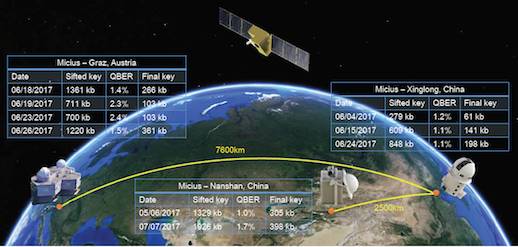This article is more than 1 year old
China flaunts quantum key distribution in-SPAAACE by securing videoconference
Satellite carries keys to Graz
China has revealed more detail of its much-hyped satellite quantum key distribution network.
In a paper published at Physical Review Letters, Liao Shengkai of University of Science and Technology of China and other researchers describe the experiment in which they passed quantum-created keys between Xinglong and Graz in Austria.
In quantum key distribution (QKD), the keys used to secure communications take advantage of quantum entanglement to protect secret keys against eavesdropping. Those keys are then used to secure communications transmitted over non-quantum channels.
The Chinese experiment demonstrated communication with transmitted images, and followed that up with a 75-minute videoconference on 29 September 2017 secured with quantum-distributed keys.
This is already commonplace on terrestrial fibre networks. China set its sights higher when it launched a satellite named "Micius" in 2016. That craft can create entangled particles used to carry encryption keys.
In June 2017, Chinese researchers demonstrated they could maintain space-to-ground entanglement, and at the same time, also maintained entanglement over a record distance, 1,200 km, between ground stations.

Micius distributing keys. Click to embiggen
In the latest research, the researchers added an Austrian node into the mix, achieving kilohertz-rate key distribution between stations that were 7,600 km apart.
The researchers wrote that the experiment proves the value of a satellite platform like Micius, because noise limits the distance that optical fibre can be used for QKD. “Due to photon loss in the channel, the secure QKD distance by direct transmission of the single photons in optical fibres or terrestrial free space was hitherto limited to a few hundred kilometres,” the paper stated.
On a satellite channel, once the signal is out of the atmosphere, noise is far less troublesome: “most of the photons’ propagation path is in empty space with negligible loss and decoherence.”
China doesn't have the quantum space race all to itself. Last year, boffins from the University of Padua in Italy conducted their own earth-to-space experiment.
However, unlike Micius, which carries its own QKD transmitter, the Italian experiment created an entangled state on the ground and bounced it off a satellite, demonstrating that they were able to maintain the photons' quantum state on the round trip.
Japan also has a quantum satellite experiment. ®
